Abstract
The administration of intravenous agents is the most commonly used method in Canada and the United States to produce sedation or general anesthesia for dental procedures. Ketamine, a dissociative anesthetic, has several advantageous physical, pharmacokinetic, and pharmacodynamic properties. It can be used to induce anesthesia, sedation, analgesia, and amnesia. Ketamine can maintain functional residual capacity, induce bronchodilation, and avoid cardiovascular depression. However, adverse effects have been demonstrated, such as cardiovascular stimulation and unpleasant emergence phenomena, both of which may be modulated by supplementation with benzodiazepines. An increase in the use of ketamine for ambulatory anesthesia has recently been advocated. This review of the literature supports the use of ketamine as an effective agent for selected anesthetic procedures.
Full text
PDF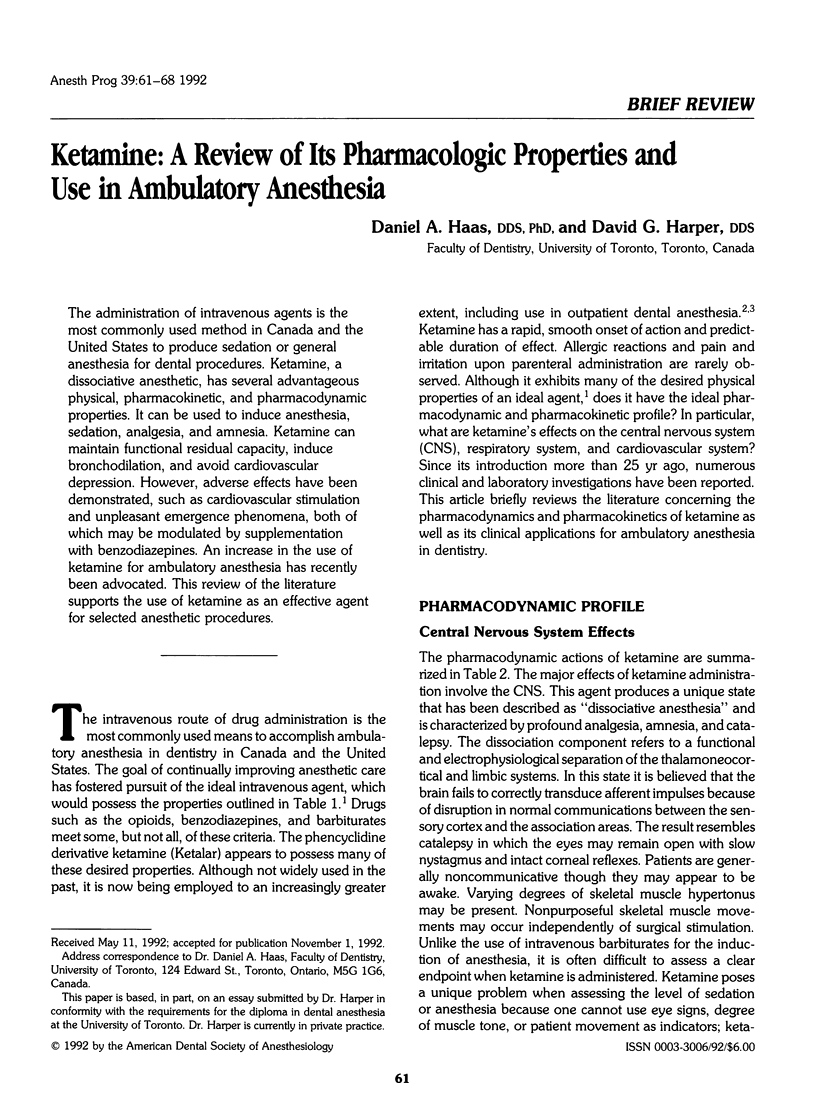
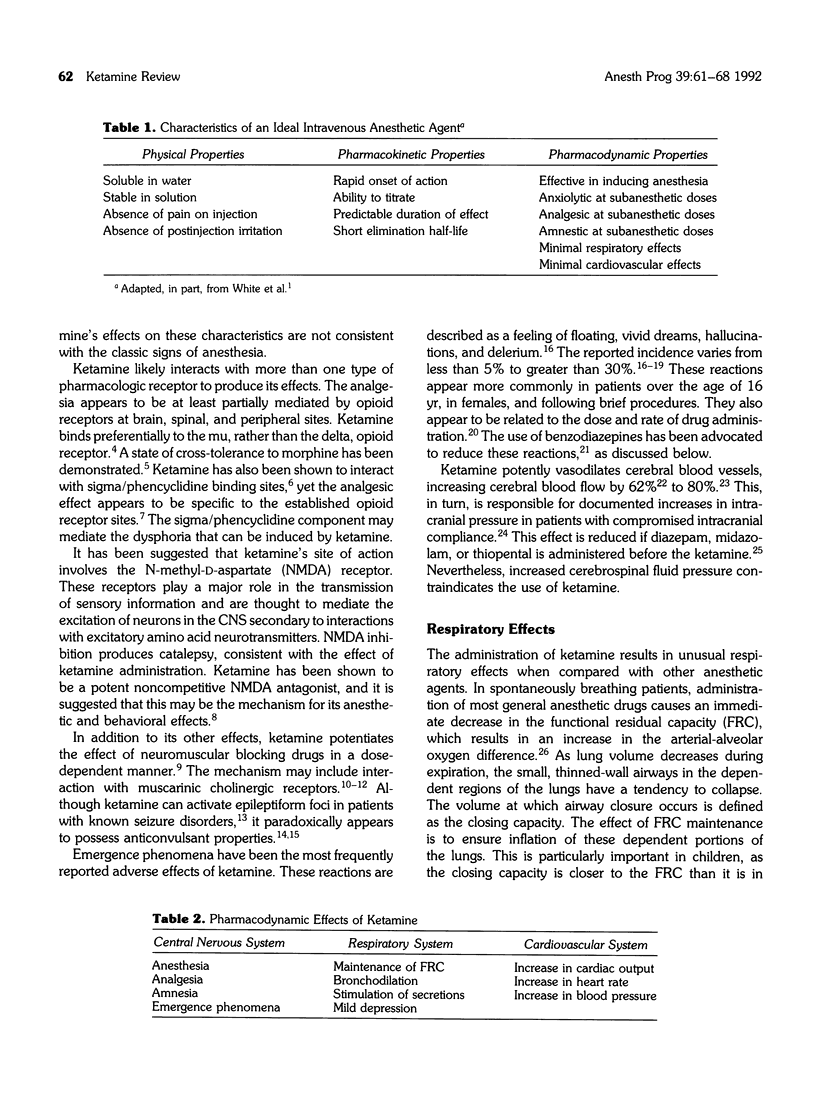
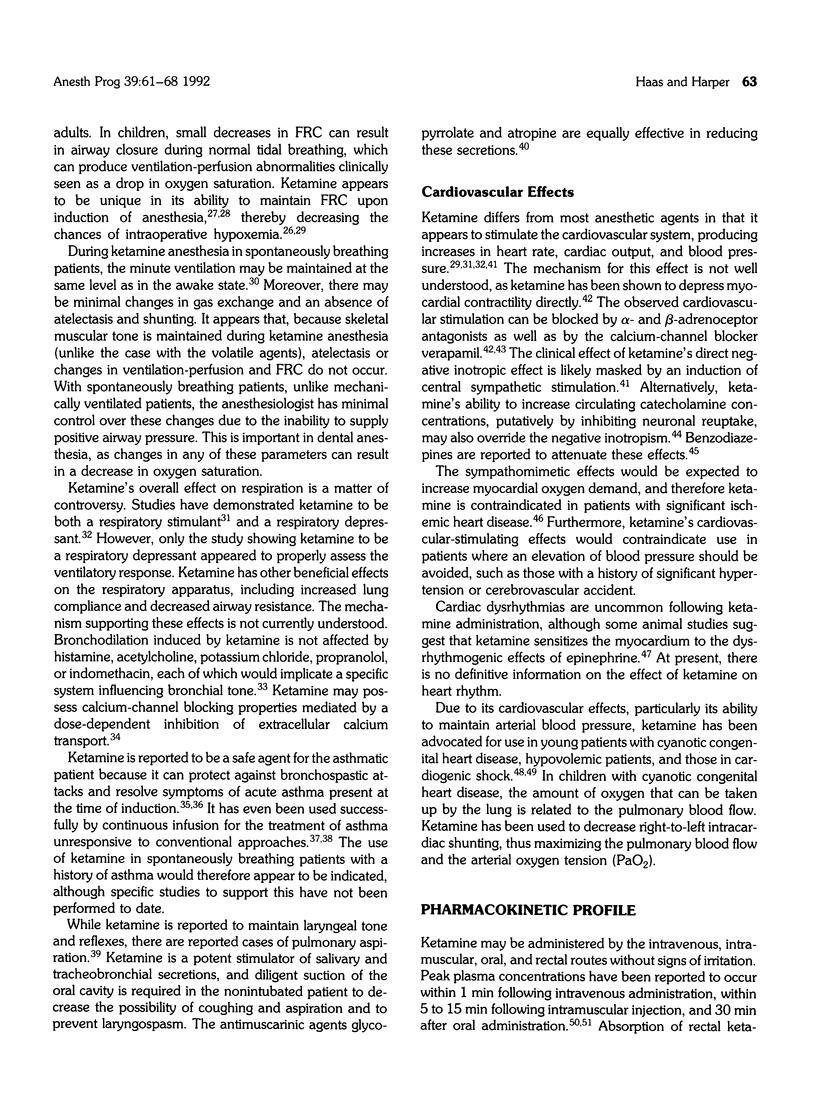
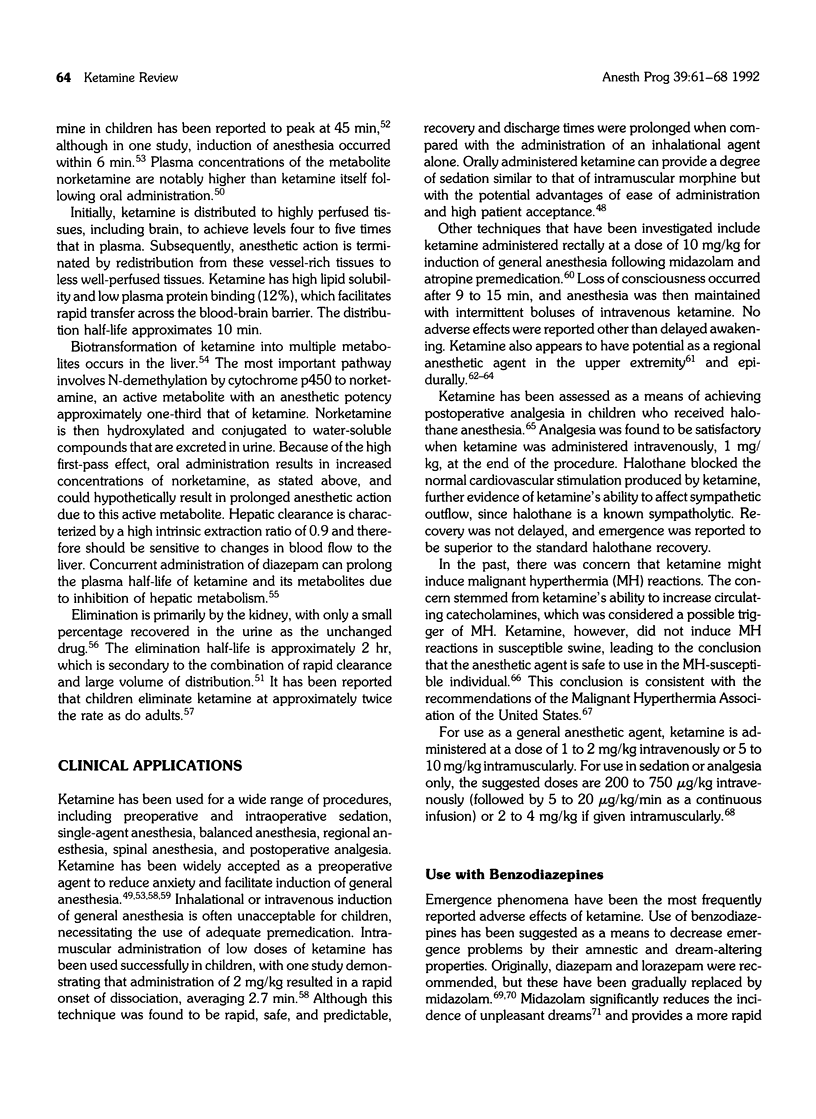

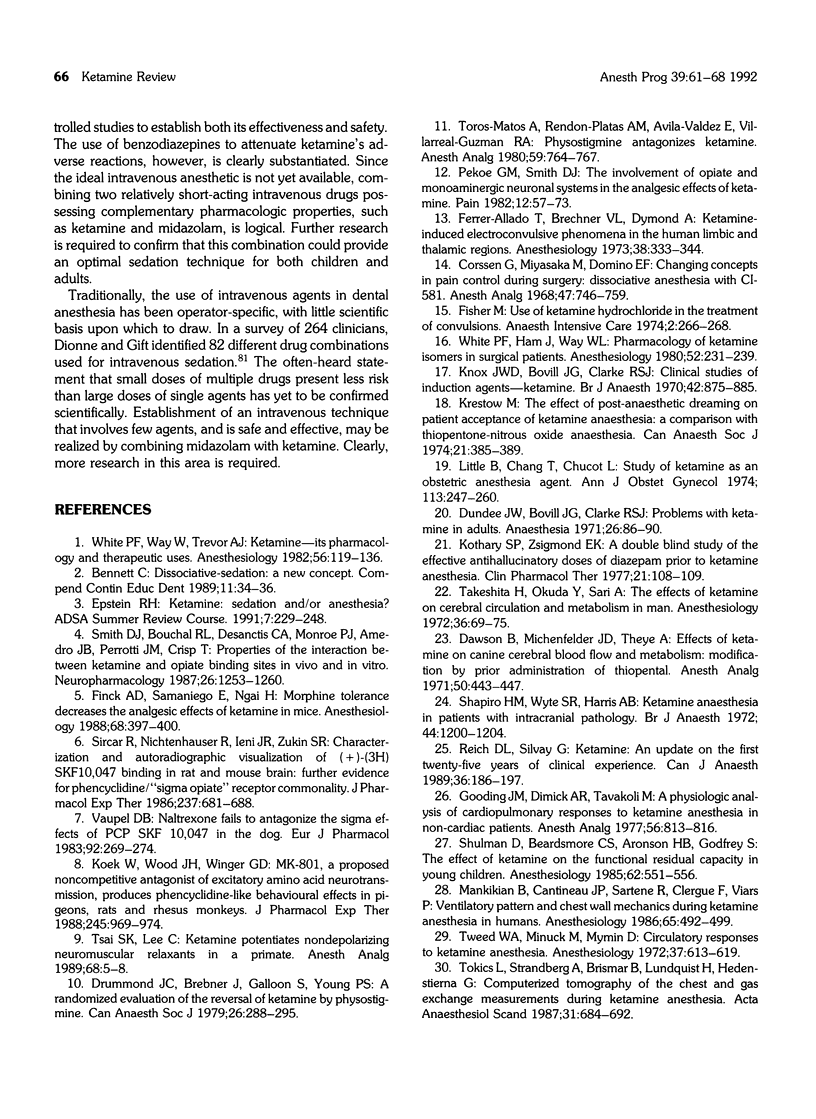
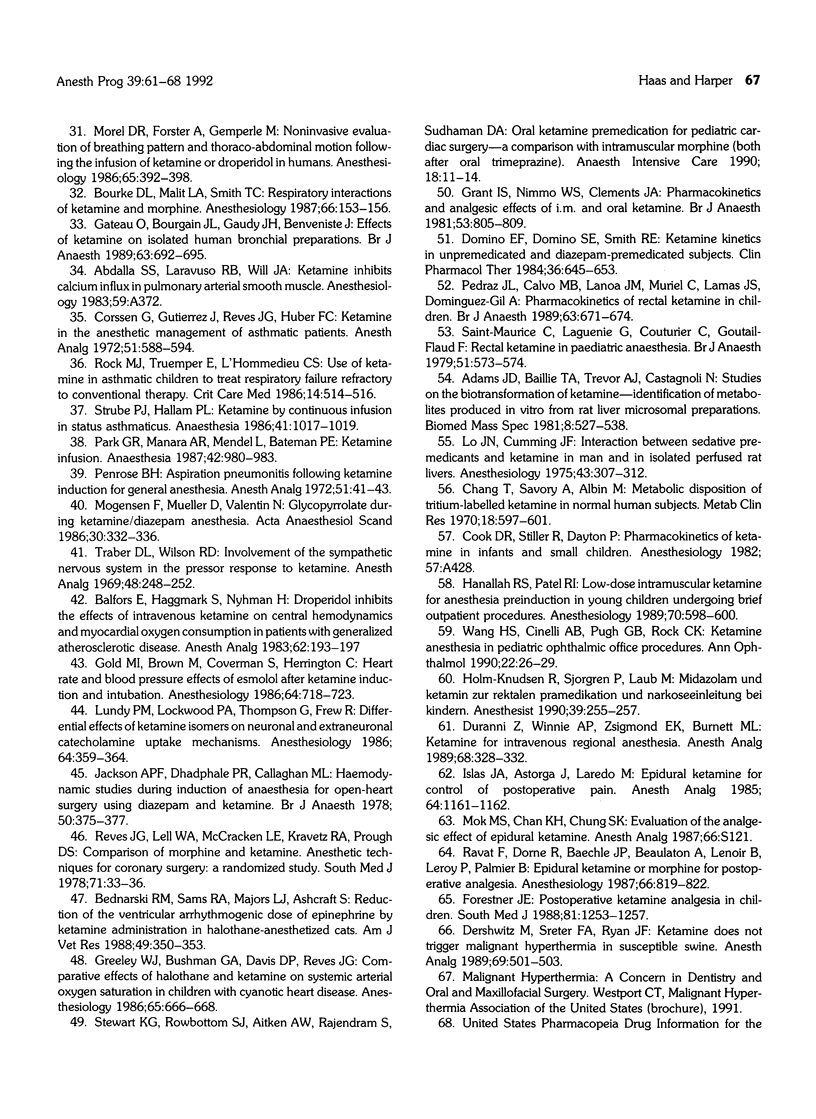
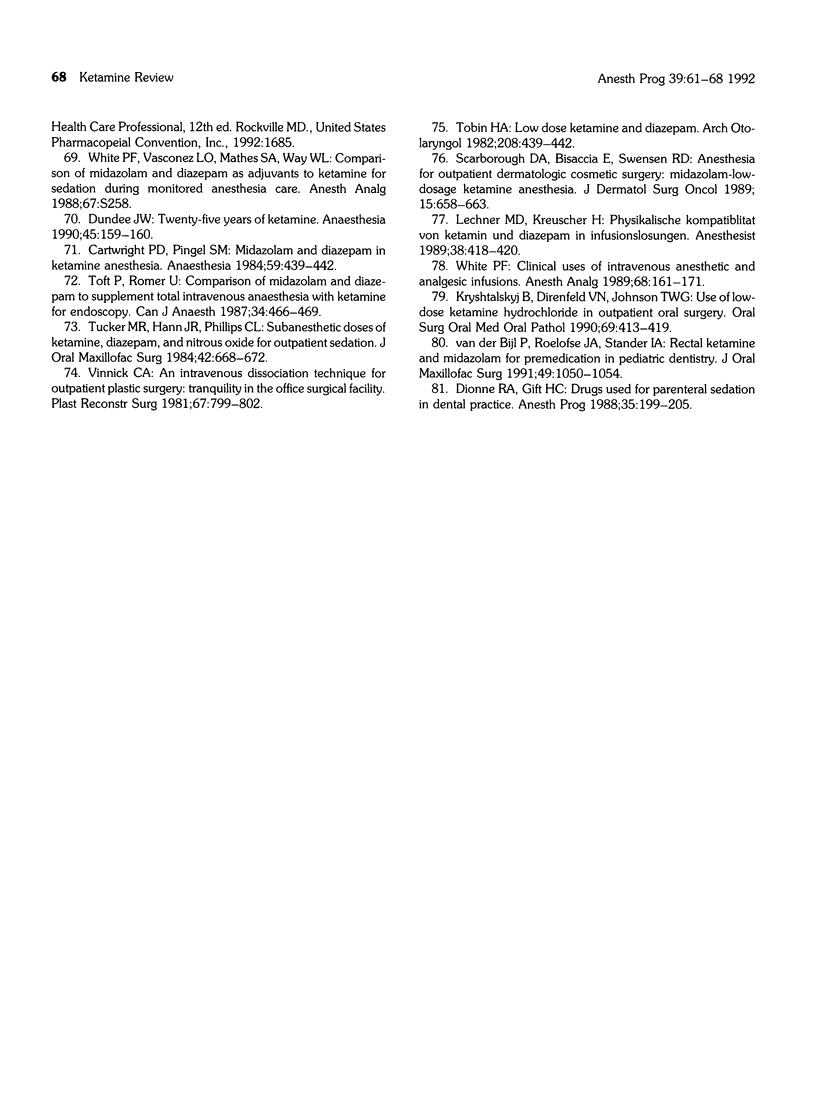
Selected References
These references are in PubMed. This may not be the complete list of references from this article.
- Adams J. D., Jr, Baillie T. A., Trevor A. J., Castagnoli N., Jr Studies on the biotransformation of ketamine. 1-Identification of metabolites produced in vitro from rat liver microsomal preparations. Biomed Mass Spectrom. 1981 Nov;8(11):527–538. doi: 10.1002/bms.1200081103. [DOI] [PubMed] [Google Scholar]
- Bednarski R. M., Sams R. A., Majors L. J., Ashcraft S. Reduction of the ventricular arrhythmogenic dose of epinephrine by ketamine administration in halothane-anesthetized cats. Am J Vet Res. 1988 Mar;49(3):350–354. [PubMed] [Google Scholar]
- Bennett C. R. Dissociative-sedation: a new concept. Compendium. 1990 Jan;11(1):34, 36-8. [PubMed] [Google Scholar]
- Bourke D. L., Malit L. A., Smith T. C. Respiratory interactions of ketamine and morphine. Anesthesiology. 1987 Feb;66(2):153–156. doi: 10.1097/00000542-198702000-00008. [DOI] [PubMed] [Google Scholar]
- Bålfors E., Häggmark S., Nyhman H., Rydvall A., Reiz S. Droperidol inhibits the effects of intravenous ketamine on central hemodynamics and myocardial oxygen consumption in patients with generalized atherosclerotic disease. Anesth Analg. 1983 Feb;62(2):193–197. [PubMed] [Google Scholar]
- Cartwright P. D., Pingel S. M. Midazolam and diazepam in ketamine anaesthesia. Anaesthesia. 1984 May;39(5):439–442. doi: 10.1111/j.1365-2044.1984.tb07312.x. [DOI] [PubMed] [Google Scholar]
- Corssen G., Gutierrez J., Reves J. G., Huber F. C., Jr Ketamine in the anesthetic management of asthmatic patients. Anesth Analg. 1972 Jul-Aug;51(4):588–596. [PubMed] [Google Scholar]
- Corssen G., Miyasaka M., Domino E. F. Changing concepts in pain control during surgery: dissociative anesthesia with CI-581. A progress report. Anesth Analg. 1968 Nov-Dec;47(6):746–759. [PubMed] [Google Scholar]
- Dawson B., Michenfelder J. D., Theye R. A. Effects of ketamine on canine cerebral blood flow and metabolism: modification by prior administration of thiopental. Anesth Analg. 1971 May-Jun;50(3):443–447. [PubMed] [Google Scholar]
- Dershwitz M., Sréter F. A., Ryan J. F. Ketamine does not trigger malignant hyperthermia in susceptible swine. Anesth Analg. 1989 Oct;69(4):501–503. [PubMed] [Google Scholar]
- Dionne R. A., Gift H. C. Drugs used for parenteral sedation in dental practice. Anesth Prog. 1988 Sep-Oct;35(5):199–205. [PMC free article] [PubMed] [Google Scholar]
- Domino E. F., Domino S. E., Smith R. E., Domino L. E., Goulet J. R., Domino K. E., Zsigmond E. K. Ketamine kinetics in unmedicated and diazepam-premedicated subjects. Clin Pharmacol Ther. 1984 Nov;36(5):645–653. doi: 10.1038/clpt.1984.235. [DOI] [PubMed] [Google Scholar]
- Drummond J. C., Brebner J., Galloon S., Young P. S. A randomized evaluation of the reversal of ketamine by physostigmine. Can Anaesth Soc J. 1979 Jul;26(4):288–295. doi: 10.1007/BF03006289. [DOI] [PubMed] [Google Scholar]
- Dundee J. W., Bovill J. G., Clarke R. S., Pandit S. K. Problems with ketamine in adults. Anaesthesia. 1971 Jan;26(1):86–86. doi: 10.1111/j.1365-2044.1971.tb04721.x. [DOI] [PubMed] [Google Scholar]
- Dundee J. W. Twenty-five years of ketamine. A report of an international meeting. Anaesthesia. 1990 Feb;45(2):159–159. doi: 10.1111/j.1365-2044.1990.tb14287.x. [DOI] [PubMed] [Google Scholar]
- Durrani Z., Winnie A. P., Zsigmond E. K., Burnett M. L. Ketamine for intravenous regional anesthesia. Anesth Analg. 1989 Mar;68(3):328–332. [PubMed] [Google Scholar]
- Ferrer-Allado T., Brechner V. L., Dymond A., Cozen H., Crandall P. Ketamine-induced electroconvulsive phenomena in the human limbic and thalamic regions. Anesthesiology. 1973 Apr;38(4):333–344. doi: 10.1097/00000542-197304000-00006. [DOI] [PubMed] [Google Scholar]
- Finck A. D., Samaniego E., Ngai S. H. Morphine tolerance decreases the analgesic effects of ketamine in mice. Anesthesiology. 1988 Mar;68(3):397–400. doi: 10.1097/00000542-198803000-00013. [DOI] [PubMed] [Google Scholar]
- Fisher M. M. Use of ketamine hydrochloride in the treatment of convulsions. Anaesth Intensive Care. 1974 Aug;2(3):266–268. doi: 10.1177/0310057X7400200313. [DOI] [PubMed] [Google Scholar]
- Forestner J. E. Postoperative ketamine analgesia in children: efficacy and safety after halothane anesthesia. South Med J. 1988 Oct;81(10):1253–1257. doi: 10.1097/00007611-198810000-00013. [DOI] [PubMed] [Google Scholar]
- Gateau O., Bourgain J. L., Gaudy J. H., Benveniste J. Effects of ketamine on isolated human bronchial preparations. Br J Anaesth. 1989 Dec;63(6):692–695. doi: 10.1093/bja/63.6.692. [DOI] [PubMed] [Google Scholar]
- Gold M. I., Brown M., Coverman S., Herrington C. Heart rate and blood pressure effects of esmolol after ketamine induction and intubation. Anesthesiology. 1986 Jun;64(6):718–723. doi: 10.1097/00000542-198606000-00007. [DOI] [PubMed] [Google Scholar]
- Gooding J. M., Dimick A. R., Tavakoli M., Corssen G. A physiologic analysis of cardiopulmonary responses to ketamine anesthesia in noncardiac patients. Anesth Analg. 1977 Nov-Dec;56(6):813–816. [PubMed] [Google Scholar]
- Grant I. S., Nimmo W. S., Clements J. A. Pharmacokinetics and analgesic effects of i.m. and oral ketamine. Br J Anaesth. 1981 Aug;53(8):805–810. doi: 10.1093/bja/53.8.805. [DOI] [PubMed] [Google Scholar]
- Greeley W. J., Bushman G. A., Davis D. P., Reves J. G. Comparative effects of halothane and ketamine on systemic arterial oxygen saturation in children with cyanotic heart disease. Anesthesiology. 1986 Dec;65(6):666–668. doi: 10.1097/00000542-198612000-00018. [DOI] [PubMed] [Google Scholar]
- Hannallah R. S., Patel R. I. Low-dose intramuscular ketamine for anesthesia pre-induction in young children undergoing brief outpatient procedures. Anesthesiology. 1989 Apr;70(4):598–600. doi: 10.1097/00000542-198904000-00007. [DOI] [PubMed] [Google Scholar]
- Holm-Knudsen R., Sjøgren P., Laub M. Midazolam und Ketamin zur rektalen Prämedikation und Narkoseeinleitung bei Kindern. Anaesthesist. 1990 May;39(5):255–257. [PubMed] [Google Scholar]
- Islas J. A., Astorga J., Laredo M. Epidural ketamine for control of postoperative pain. Anesth Analg. 1985 Dec;64(12):1161–1162. [PubMed] [Google Scholar]
- Jackson A. P., Dhadphale P. R., Callaghan M. L., Alseri S. Haemodynamic studies during induction of anaesthesia for open-heart surgery using diazepam and ketamine. Br J Anaesth. 1978 Apr;50(4):375–378. doi: 10.1093/bja/50.4.375. [DOI] [PubMed] [Google Scholar]
- Knox J. W., Bovill J. G., Clarke R. S., Dundee J. W. Clinical studies of induction agents. XXXVI: Ketamine. Br J Anaesth. 1970 Oct;42(10):875–885. doi: 10.1093/bja/42.10.875. [DOI] [PubMed] [Google Scholar]
- Koek W., Woods J. H., Winger G. D. MK-801, a proposed noncompetitive antagonist of excitatory amino acid neurotransmission, produces phencyclidine-like behavioral effects in pigeons, rats and rhesus monkeys. J Pharmacol Exp Ther. 1988 Jun;245(3):969–974. [PubMed] [Google Scholar]
- Krestow M. The effect of post-anaesthetic dreaming on patient acceptance of ketamine anaesthesia: a comparison with thiopentone-nitrous oxide anaesthesia. Can Anaesth Soc J. 1974 Jul;21(4):385–389. doi: 10.1007/BF03006072. [DOI] [PubMed] [Google Scholar]
- Kryshtalskyj B., Direnfeld V. N., Johnson T. W. Use of low-dose ketamine hydrochloride in outpatient oral surgery. Oral Surg Oral Med Oral Pathol. 1990 Apr;69(4):413–419. doi: 10.1016/0030-4220(90)90371-x. [DOI] [PubMed] [Google Scholar]
- Lechner M. D., Kreuscher H. Physikalische Kompatibilität von Ketamin und Diazepam in Infusionslösungen. Anaesthesist. 1989 Aug;38(8):418–420. [PubMed] [Google Scholar]
- Little B., Chang T., Chucot L., Dill W. A., Enrile L. L., Glazko A. J., Jassani M., Kretchmer H., Sweet A. Y. Study of ketamine as an obstetric anesthetic agent. Am J Obstet Gynecol. 1972 May 15;113(2):247–260. doi: 10.1016/0002-9378(72)90774-0. [DOI] [PubMed] [Google Scholar]
- Lo J. N., Cumming J. F. Interaction between sedative premedicants and ketamine in man in isolated perfused rat livers. Anesthesiology. 1975 Sep;43(3):307–312. doi: 10.1097/00000542-197509000-00007. [DOI] [PubMed] [Google Scholar]
- Lundy P. M., Lockwood P. A., Thompson G., Frew R. Differential effects of ketamine isomers on neuronal and extraneuronal catecholamine uptake mechanisms. Anesthesiology. 1986 Mar;64(3):359–363. doi: 10.1097/00000542-198603000-00010. [DOI] [PubMed] [Google Scholar]
- Mankikian B., Cantineau J. P., Sartene R., Clergue F., Viars P. Ventilatory pattern and chest wall mechanics during ketamine anesthesia in humans. Anesthesiology. 1986 Nov;65(5):492–499. doi: 10.1097/00000542-198611000-00007. [DOI] [PubMed] [Google Scholar]
- Mogensen F., Müller D., Valentin N. Glycopyrrolate during ketamine/diazepam anaesthesia. A double-blind comparison with atropine. Acta Anaesthesiol Scand. 1986 May;30(4):332–336. doi: 10.1111/j.1399-6576.1986.tb02425.x. [DOI] [PubMed] [Google Scholar]
- Morel D. R., Forster A., Gemperle M. Noninvasive evaluation of breathing pattern and thoraco-abdominal motion following the infusion of ketamine or droperidol in humans. Anesthesiology. 1986 Oct;65(4):392–398. doi: 10.1097/00000542-198610000-00008. [DOI] [PubMed] [Google Scholar]
- Park G. R., Manara A. R., Mendel L., Bateman P. E. Ketamine infusion. Its use as a sedative, inotrope and bronchodilator in a critically ill patient. Anaesthesia. 1987 Sep;42(9):980–983. doi: 10.1111/j.1365-2044.1987.tb05370.x. [DOI] [PubMed] [Google Scholar]
- Pedraz J. L., Calvo M. B., Lanao J. M., Muriel C., Santos Lamas J., Domínguez-Gil A. Pharmacokinetics of rectal ketamine in children. Br J Anaesth. 1989 Dec;63(6):671–674. doi: 10.1093/bja/63.6.671. [DOI] [PubMed] [Google Scholar]
- Pekoe G. M., Smith D. J. The involvement of opiate and monoaminergic neuronal systems in the analgesic effects of ketamine. Pain. 1982 Jan;12(1):57–73. doi: 10.1016/0304-3959(82)90170-1. [DOI] [PubMed] [Google Scholar]
- Penrose B. H. Aspiration pneumonitis following ketamine induction for general anesthesia. Anesth Analg. 1972 Jan-Feb;51(1):41–43. [PubMed] [Google Scholar]
- Ravat F., Dorne R., Baechle J. P., Beaulaton A., Lenoir B., Leroy P., Palmier B. Epidural ketamine or morphine for postoperative analgesia. Anesthesiology. 1987 Jun;66(6):819–822. doi: 10.1097/00000542-198706000-00019. [DOI] [PubMed] [Google Scholar]
- Reich D. L., Silvay G. Ketamine: an update on the first twenty-five years of clinical experience. Can J Anaesth. 1989 Mar;36(2):186–197. doi: 10.1007/BF03011442. [DOI] [PubMed] [Google Scholar]
- Reves J. G., Lell W. A., McCracken L. E., Jr, Kravetz R. A., Prough D. S. Comparison of morphine and ketamine anesthetic technics for coronary surgery: a randomized study. South Med J. 1978 Jan;71(1):33–36. doi: 10.1097/00007611-197801000-00011. [DOI] [PubMed] [Google Scholar]
- Rock M. J., Reyes de la Rocha S., L'Hommedieu C. S., Truemper E. Use of ketamine in asthmatic children to treat respiratory failure refractory to conventional therapy. Crit Care Med. 1986 May;14(5):514–516. doi: 10.1097/00003246-198605000-00019. [DOI] [PubMed] [Google Scholar]
- Saint-Maurice C., Laguenie G., Couturier C., Goutail-Flaud F. Rectal ketamine in paediatric anaesthesia. Br J Anaesth. 1979 Jun;51(6):573–574. doi: 10.1093/bja/51.6.573-b. [DOI] [PubMed] [Google Scholar]
- Scarborough D. A., Bisaccia E., Swensen R. D. Anesthesia for outpatient dermatologic cosmetic surgery: midazolam--low-dosage ketamine anesthesia. J Dermatol Surg Oncol. 1989 Jun;15(6):658–663. doi: 10.1111/j.1524-4725.1989.tb03605.x. [DOI] [PubMed] [Google Scholar]
- Shaprio H. M., Wyte S. R., Harris A. B. Ketamine anaesthesia in patients with intracranial pathology. Br J Anaesth. 1972 Nov;44(11):1200–1204. doi: 10.1093/bja/44.11.1200. [DOI] [PubMed] [Google Scholar]
- Shulman D., Beardsmore C. S., Aronson H. B., Godfrey S. The effect of ketamine on the functional residual capacity in young children. Anesthesiology. 1985 May;62(5):551–556. doi: 10.1097/00000542-198505000-00001. [DOI] [PubMed] [Google Scholar]
- Sircar R., Nichtenhauser R., Ieni J. R., Zukin S. R. Characterization and autoradiographic visualization of (+)-[3H]SKF10,047 binding in rat and mouse brain: further evidence for phencyclidine/"sigma opiate" receptor commonality. J Pharmacol Exp Ther. 1986 May;237(2):681–688. [PubMed] [Google Scholar]
- Smith D. J., Bouchal R. L., deSanctis C. A., Monroe P. J., Amedro J. B., Perrotti J. M., Crisp T. Properties of the interaction between ketamine and opiate binding sites in vivo and in vitro. Neuropharmacology. 1987 Sep;26(9):1253–1260. doi: 10.1016/0028-3908(87)90084-0. [DOI] [PubMed] [Google Scholar]
- Stewart K. G., Rowbottom S. J., Aitken A. W., Rajendram S., Sudhaman D. A. Oral ketamine premedication for paediatric cardiac surgery--a comparison with intramuscular morphine (both after oral trimeprazine). Anaesth Intensive Care. 1990 Feb;18(1):11–14. doi: 10.1177/0310057X9001800103. [DOI] [PubMed] [Google Scholar]
- Strube P. J., Hallam P. L. Ketamine by continuous infusion in status asthmaticus. Anaesthesia. 1986 Oct;41(10):1017–1019. doi: 10.1111/j.1365-2044.1986.tb12744.x. [DOI] [PubMed] [Google Scholar]
- Takeshita H., Okuda Y., Sari A. The effects of ketamine on cerebral circulation and metabolism in man. Anesthesiology. 1972 Jan;36(1):69–75. doi: 10.1097/00000542-197201000-00013. [DOI] [PubMed] [Google Scholar]
- TobiN H. A. Low-dose ketamine and diazepam. Use as an adjunct to local anesthesia in an office operating room. Arch Otolaryngol. 1982 Jul;108(7):439–440. doi: 10.1001/archotol.1982.00790550043011. [DOI] [PubMed] [Google Scholar]
- Toft P., Romer U. Comparison of midazolam and diazepam to supplement total intravenous anaesthesia with ketamine for endoscopy. Can J Anaesth. 1987 Sep;34(5):466–469. doi: 10.1007/BF03014351. [DOI] [PubMed] [Google Scholar]
- Tokics L., Strandberg A., Brismar B., Lundquist H., Hedenstierna G. Computerized tomography of the chest and gas exchange measurements during ketamine anaesthesia. Acta Anaesthesiol Scand. 1987 Nov;31(8):684–692. doi: 10.1111/j.1399-6576.1987.tb02646.x. [DOI] [PubMed] [Google Scholar]
- Toro-Matos A., Rendon-Platas A. M., Avila-Valdez E., Villarreal-Guzman R. A. Physostigmine antagonizes ketamine. Anesth Analg. 1980 Oct;59(10):764–767. [PubMed] [Google Scholar]
- Traber D. L., Wilson R. D. Involvement of the sympathetic nervous system in the pressor response to ketamine. Anesth Analg. 1969 Mar-Apr;48(2):248–252. [PubMed] [Google Scholar]
- Tsai S. K., Lee C. Ketamine potentiates nondepolarizing neuromuscular relaxants in a primate. Anesth Analg. 1989 Jan;68(1):5–8. [PubMed] [Google Scholar]
- Tucker M. R., Hann J. R., Phillips C. L. Subanesthetic doses of ketamine, diazepam, and nitrous oxide for adult outpatient sedation. J Oral Maxillofac Surg. 1984 Oct;42(10):668–672. doi: 10.1016/0278-2391(84)90210-6. [DOI] [PubMed] [Google Scholar]
- Tweed W. A., Minuck M., Mymin D. Circulatory responses to ketamine anesthesia. Anesthesiology. 1972 Dec;37(6):613–619. doi: 10.1097/00000542-197212000-00008. [DOI] [PubMed] [Google Scholar]
- Vaupel D. B. Naltrexone fails to antagonize the sigma effects of PCP and SKF 10,047 in the dog. Eur J Pharmacol. 1983 Sep 2;92(3-4):269–274. doi: 10.1016/0014-2999(83)90297-2. [DOI] [PubMed] [Google Scholar]
- Vinnik C. A. An intravenous dissociation technique for outpatient plastic surgery: tranquility in the office surgical facility. Plast Reconstr Surg. 1981 Jun;67(6):799–805. doi: 10.1097/00006534-198106000-00016. [DOI] [PubMed] [Google Scholar]
- Wang H. S., Cinelli A. B., Pugh G. B., Rock C. K. Ketamine anesthesia in pediatric ophthalmic office procedures (October 1985-October 1986). Ann Ophthalmol. 1990 Jan;22(1):26–29. [PubMed] [Google Scholar]
- White P. F. Clinical uses of intravenous anesthetic and analgesic infusions. Anesth Analg. 1989 Feb;68(2):161–171. doi: 10.1213/00000539-198902000-00017. [DOI] [PubMed] [Google Scholar]
- White P. F., Ham J., Way W. L., Trevor A. J. Pharmacology of ketamine isomers in surgical patients. Anesthesiology. 1980 Mar;52(3):231–239. doi: 10.1097/00000542-198003000-00008. [DOI] [PubMed] [Google Scholar]
- White P. F., Way W. L., Trevor A. J. Ketamine--its pharmacology and therapeutic uses. Anesthesiology. 1982 Feb;56(2):119–136. doi: 10.1097/00000542-198202000-00007. [DOI] [PubMed] [Google Scholar]
- van der Bijl P., Roelofse J. A., Stander I. A. Rectal ketamine and midazolam for premedication in pediatric dentistry. J Oral Maxillofac Surg. 1991 Oct;49(10):1050–1054. doi: 10.1016/0278-2391(91)90136-a. [DOI] [PubMed] [Google Scholar]


